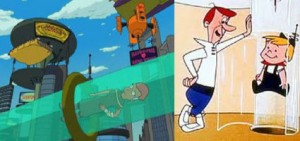Futurama’s Tube Transport system, available in every city except Los Angeles, uses electromagnets and air pressure to propel passengers to their destinations. The Jetsons had a similar transportation system, as do worlds in sci-fi written by Robert Heinlein, Arthur Clarke, and Ray Bradbury, among others.
The tube system of transport, known as the “vacutube” or “bounce tube” in science fiction, resembles the pneumatic tubes used in drive-up banking transactions, and the postal service tubes that were used in the late 1800s. While it might seem that a tube capable of transporting is quite a leap from the tube that sucks up your savings account deposit, it appears that engineers are in the process of making this leap. In other words, perhaps the most unrealistic aspect of the Futurama tube transport system is that it’s free to use.
In 1812, George Medhurst proposed using a tube system for public transportation. While his vision wasn’t quite realized, a somewhat similar model, the atmospheric railway, was adopted for some time. The atmospheric railway is a lot like the air-propelled train that shuttles Guy Montag and others around in Bradbury’s Fahrenheit 451.
The atmospheric railway uses air pressure for propulsion. Depending on the model, it either runs on a tube that sits between the rails which is connected to the train via a suspended piston, or the car itself acts as the piston with the tunnel acting as the tube. Engines set up along the train’s route leave a partial vacuum just ahead of the car, while pumping air behind the car, causing atmospheric pressure to boost the train. As the name suggests, atmospheric railways eliminate friction and jerkiness, and are nearly silent. In the mid-1800s, Dublin, London, Paris all operated these trains.
So why aren’t these trains all over the place now? It’s the same reason you and I don’t have jetpacks–cost.
A number of ambitious pneumatic railways have been planned, and in some cases, construction begun, but almost all projects have been shut down due to financial problems. Digging for a railway to run under the Thames River started in 1865 but stopped three years later for lack of financial support. In 1870, an engineer named Alfred Beach unveiled a prototype for a pneumatic train subway in New York City; his model could move 12 passengers, and demonstrated the possibilities of expanding such a system city-wide. However, the city politicos put the kybosh on the idea, as they were invested in developing an elevated train instead.
Nearly a century later, MIT and Lockheed looked into building a vacuum train system that would link together cities on the East Coast, but financial problems caused developers to abandon the project. Lockheed briefly pursued a gravity-vacuum transportation system that would supplement the Bay City’s BART system, but that project also was also…well, derailed.
Currently, Brazil and Indonesia use an updated version of the atmospheric railway called Aeromovel, which consists of elevated air-propelled trains that can reach speeds of 50 mph between city stops, are entirely automated, and are virtually silent.
A company called ET3, based in Crystal River, FL, has proposed yet another leap from Aeromovel trains—they’re developing a system called Evacuated Tube Transport (ETT).
This system would use maglev trains, which work on magnetic levitation, rather than mechanical parts involving wheels and bearings. High speed bullet trains used in Europe and Asia run on maglev systems, and while most run at about 300 mph, the top speed of maglev trains in Japan is over 500 mph.
As fast as they are, maglev trains still encounter air resistance, as well as sharp turns, both of which cap their speed. The ETT system eliminates that by permanently removing all the air from the two-way tubes that comprise the travel route.
Passenger capsules would be about the size of cars and able to contain roughly six passengers each. Initially, they would be accelerated by electric motors, but then could coast through the vacuum once a certain speed is reached. Stations would have airlocks which would allow the transfer of capsules and passengers without introducing air into the tube itself. While we have the technology to make these systems now, more challenging is the laying down of straight tracks, much like freeways, from destination to destination.
Prototypes of Evacuated Tube Transports have reached speeds of approximately 370 mph, and ET3 hopes to develop the system so that trains can eventually reach speeds of about 4,000 mph during longer rides. If they achieve this, a trip from New York to Beijing would take roughly 2 hours, and a trip from New York to Los Angeles roughly 45 minutes. It’s not quite teleportation, but I’ll take it!
Here’s a longer, more technical explanation of how ETT works.
ET3 projects that their systems would require roughly .05% of the material necessary to build high-speed rails and would cost 10% as much to build, and .25% as much as it costs to construct a freeway. ET3 also claims that their system would be 50 times more efficient than electric cars or trains. If these claims are anywhere near accurate, the ETT system could revolutionize transport and minimize environmental and economic impacts in mind-boggling ways.
Soon, we might be boarding the Tube in places other than London, sliding smoothly and silently to destinations that in the olden days only could have been reached with a boarding pass, a few screaming children, a lack of legroom, and an $8 bag of pretzels.



Pingback: Transportation: What are the details of the Hyperloop, the new mode of transportation envisioned by Elon Musk? - Quora
Pingback: Is Elon Musk’s Hyperloop the ET3? | Dankind